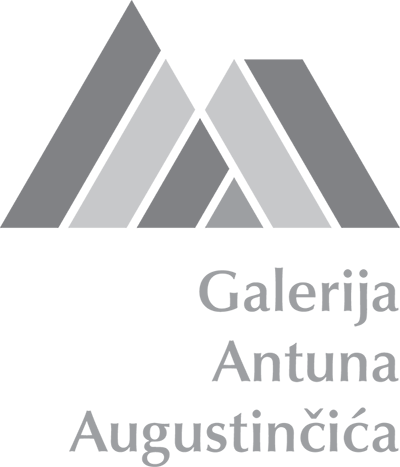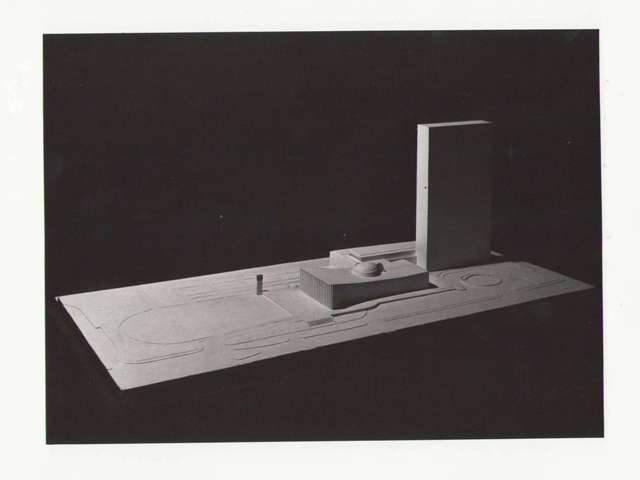PEACE, New York, 1954
Erected next to the United Nations building in New York the Peace monument by Antun Augustinčić is one of the most imposing monuments in his body of work. It is a typical example of his equestrian statues and the largest gift the United Nations have ever received. A universal message of this monument and the importance of its location have kept its symbolic and political relevance to this day.
The creation of this equestrian statue was initiated in turbulent circumstances, as evidenced in the recollections of Krešimir Horvat, a diplomat with the Yugoslav Permanent Mission to the United Nations from 1952 until 1956, and the records in the archives of the Antun Augustinčić Gallery (GAA) in Klanjec. Horvat's recollections were published in the Annals of the GAA in 1983.
After World War II, the General Assembly of the United Nations decided that the headquarters would be established in New York City, USA. For this purpose, in 1946 the Rockefeller family donated funds for the acquisition of a tract of land in Manhattan bounded by First Avenue, East River, East 48th Street, and East 42nd Street. Construction of the building complex began in 1949 and each member state was assigned a task of refining the space. For instance, the Scandinavian countries organized and decorated the interior of the Security Council, India and other Asian countries donated large handmade carpets for the halls, tapestries were made, renowned painters donated their paintings, etc. Krešimir Horvat notes that the then government of Yugoslavia “decided to make a gift to the UN that would emphasize its commitment to world peace” and that “Antun Augustinčić was asked to execute this idea”. Augustinčić accepted the task and proposed an equestrian statue that would symbolize world peace. He opted for a female figure on horseback and later explained his choice to the journalists by saying that “peace would be far better protected if the decision rested with women instead of men”. When challenged that horse was a war animal, he replied that “... we must fight for peace”. In 1952 Augustinčić finished the sketch. It showed the future monument in great detail: a triumphant female figure looking resolutely straight ahead, holding a globe in her right hand and an olive branch in her raised left hand. The cape fluttering behind her and the horse in motion suggest a determined direction forward, that is, a symbolic leadership of the world nations toward peace. This is why this composition, apart from its name Peace (or Peace Monument), has another name: The Herald of Peace.
In 1952, when the UN complex was largely completed, Augustinčić travelled to New York, to decide on the exact location of the monument on the spot. In agreement with architect Wallace K. Harrison, the Director of Planning for the UN headquarters, it was decided that the monument should be installed in front of the General Assembly building, on the large plateau alongside the northern entrance, through which thousands of visitors pass every day. Augustinčić wanted the monument to be placed in an eurythmic way, as he put it, having in mind a harmonious relations of the position and dimension of the monument, of its viewpoint and rhythm. The monument was to create an ensemble with the cuboids of the UN buildings in an imagined line of perspective starting on the top of the 160-metre building of the Secretariat, down the low-lying building of the General Assembly, and Peace was to be the “final chord” of the entire complex. Augustinčić wanted to avoid a stereotypical placement of the monument on the main axis of the plateau. Instead, he envisioned the monument in the corner of the plateau, positioned in such a way that its silhouette would be visible against the East River (Fig. 1). The proposal was presented to the UN Commission composed of representatives of the United States, United Kingdom, Sweden, France, and Mexico. The Commission and the Secretary General, Norwegian Trygve H. Lie, approved the proposal and Augustinčić returned to Zagreb to start working on the monument.
The plan was to unveil the monument in the autumn of 1953, but the work was prolonged. In Augustinčić's Master Workshop in Zagreb sculptor Velibor Mačukatin did most of the clay modelling (Fig. 2), while founder Josip Kroflin managed its casting in bronze at the Art Foundry of the Academy of Fine Arts in Zagreb. Architect Lovro Bilinić was tasked with the preparation of stone for the panelling of the 10-metre tall concrete base of the monument. With Augustinčić's consent, he chose red stone from the Đurići – Kamenare quarry near Kotor, Montenegro, and arranged with a local contractor to extract and deliver raw stone blocks. In February and March of 1954 Bilinić inspected the delivered stone. The stone blocks were then moved to his stone-cutting workshop in Zagreb. After several months of work, the blocks were loaded onto the ship Macedonia and Lovro Bilinić oversaw their transportation to New York. In the summer of 1954 he met there with Wallace K. Harrison and Ernest Weissman, a civil engineer from Zagreb, to work out all preparation details for the installment of the monument. Meanwhile, the equestrian statue was cast in bronze at the Art Foundry of the Academy of Fine Arts in Zagreb and transported to Rijeka, where it was to be loaded onto the ship Srbija destined for New York. Escorted by Antun Augustinčić and founder Josip Kroflin Peace arrived in the Brooklyn harbour in October of 1954, where it was unloaded (Fig. 3) and stored. In the meantime, preparations of the grounds for the monument instalment ran into difficulty. The newly elected UN Secretary General, Dag Hammarskjöld, changed the decision on the location of the monument. Krešimir Horvat wrote that “... [Hammarskjöld] strongly disliked the idea of placing the monument on the plateau next to the General Assembly building and suggested simply that it should be installed at the end of the big lawn, close to the East River, approximately 200 metres away from the originally agreed position which Augustinčić had had in mind when making the final touches on the monument”. This decision was a very unpleasant surprise for Augustinčić but despite his resentment and counter-arguments the monument was given a new position. Finally, the new spot was approximately 40 metres away from the original one and although it gave the monument more space, the concept of its organic connection with the General Assembly building that Augustinčić had envisioned was now lost. With media attention and police escort, on December 1 Peace was hauled through the streets of New York (Fig. 4) and brought to the UN headquarters, where it was mounted to the prepared base (Figs. 5, 6, 7).
With a ceremony and in the presence of the media, on December 2, 1954 Peace was unveiled by UN Secretary General Dag Hammarskjöld, chairman of the Ninth UN General Assembly Eelco Van Klefens, and Head of the Yugoslav Permanent Mission to the UN Dr Jože Brilej (Fig. 8). Augustinčić was not present because he was then working on a new project, Monument to the Victims of Fascism, in Addis Ababa, Ethiopia. A year later, he received the Award of the City of Zagreb for Peace.
The Peace monument is 5.5 metres tall and weighs 7.5 tonnes. It is noticeable from all sides and continues to dominate the area (Figs. 9, 10, 11). However, the monument was not quite left in peace. In the 1950s, the red stone on the base was replaced by white stone from the island of Brač, and in 1979 the whole statue was temporarily removed due to the construction of the underground public parking garage. Over time, this equestrian statue became emblematic for both the sculptor and the era. Augustinčić solidified his career as a sculptor whose works were welcome in the forging of cultural diplomacy of his country. The Peace monument itself also became popular: from 1965 until 1993 it was used in the design (in a mirror image) on the obverse of the 100 Yugoslav dinars banknote, and it is still part of the logo of the Croatia Film company from Zagreb (Fig. 13).
In 2008 preparations began for a large scale reconstruction of the UN headquarters building complex, which was going to include the artwork placed within the complex. Extensive restoration of the Peace monument was successfully carried out during 2016 in a joint effort by several companies in New York City. The di Domenico + Partners company developed and coordinated the entire restoration project and documentation. Conservation goals were outlined by Roussel Art Conservation. With the assistance of Craft Engineering Studio and their founder Nathaniel Stanton, they developed the detailed restoration plan. The restoration operations were carried out by Polich Tallix art foundry. Art historian Marion Kahan did curatorial research on the history of the monument and site, and oversaw the restoration. The restoration required extensive and complex structural repairs for which the bronze monument had to be dissasembled. Problematic bolts, fractures, and corroded parts had to be detected, structural material had to be tested. Based on the findings, repairs and replacements were determined and carried out. Special attention was given to the repair and reinforcement of the horse's legs, and the supports and mounting plates that connect the horse with the cement pedestal. This ensured the strength of the construction and improved static stability. Portions of the bronze surface bared or exposed during restoration were re-patinated by cupric nitrate. Interior of the statue was vacuum-cleaned of loose debris. After the restoration was completed, the statue was reassembled and mounted to the base (Figs. 14, 15, 16).
The bronze sketch and plaster model of the Peace monument are part of the permanent exhibit of the Antun Augustinčić Gallery in Klanjec. They are indubitably two of the most attractive sculptures on display. It is, therefore, understandable why the Gallery marks the International Day of Peace on 21st of September. It is the only museum in Croatia to do so. The first time the International Day of Peace was observed at the Gallery was in 2003. Croatian sculptor Sanja Sašo and Greek artist Tonia Glezakos led a creative workshop on that occasion. Since 2010 the Gallery regularly observes this day by organizing exhibitions, workshops, and lectures focusing on the subject of peace. Exhibitions held at the Gallery include Innocent/Guilty by Marijn Abelman (2010), War and Peace by Leonard Dokša (2011), My Portrait for the Museum by primary school students from Klanjec and Kumrovec (2012), Dialogue by Petar Popijač and Božidar Pejković (2013), PEACE for Peace by Nikola Džaja (2014), Peacemaking by Mile Blažević (2015) and Fear(and)PEACE by Dragoslav Dragićević (2016). In addition to its primary function of a museum exhibit, Augustinčić's Peace served as inspiration and model for an ambiance installation by Predrag Todorović, set up in the Gallery of Matica hrvatska (Croatian Cultural Society) in Zagreb in 2010.
The concept, symbolism, and manifestations of peace continue to be relevant in today's world. It is, therefore, not unfounded to anticipate that both peace and Augustinčić's Peace will continue to inspire interpretations and new works of art by future generations.
Davorin Vujčić, curator
Sources and Literature:
Arhiva GAA
Slavko Batušić: “Najnovije djelo A. Augustinčića”, Naprijed, 27. 11. 1953., p. 1–2.
N. N.: “U Njujorku će ovih dana biti otkriven Augustinčićev Spomenik mira”, Borba, Beograd, 11. 12. 1954.
N. N.: “Privremeni premještaj”, Večernji list, Zagreb, 30. 3. 1979., p. 3.
Krešimir Horvat: “Sjećanja – 30 godina spomenika MIR u New Yorku”. Anali Galerije Antuna Augustinčića, No. 3. Klanjec, 1983.
Snježana Pintarić: Javni i nadgrobni spomenici Antuna Augustinčića. Magistarski rad, Zagreb, 1992. (Arhiva GAA)
Irena Kraševac, Davorin Vujčić: “Figuracija i modernost / Razgovor s kiparom Veliborom Mačukatinom”, Kvartal / Kronika povijesti umjetnosti u Hrvatskoj, IV – 1, Zagreb, 2007.
Polich Tallix: UN Equestrian final report, 25. 7. 2016.
Marc-Christian Roussel: Peace Monument Treatment Report for Structural Repairs, 28. 8. 2016.


















